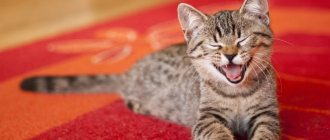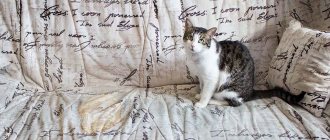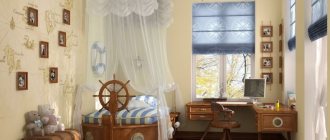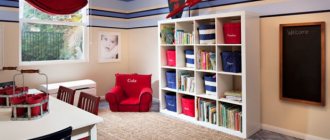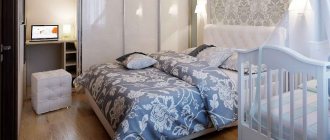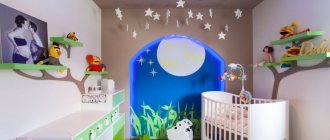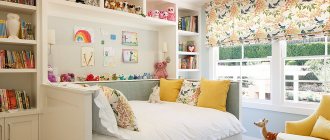13708
5 minutes
July 17, 2018
Most parents try to approach the choice of furniture and accessories for their child’s room with all responsibility. They also wonder how to choose a carpet for a child’s room so that it is practical, safe and ideally complements the interior. There are quite a lot of nuances that need to be taken into account; we will try to highlight each of them.
Purpose of a carpet for a children's room
Some parents believe that it is quite possible to do without a floor covering in the nursery, arguing that it is easier to clean the floor in the room and less dust will accumulate. They are partly right. This is especially true if we are talking about an infant who spends most of his time in a crib.
But when the baby starts crawling and more free space is needed, a children's carpet on the floor will become a necessity. You also need to prepare for the fact that as the child grows and develops, the coating will have to be changed several times, which will happen both due to its contamination and damage, and as its purpose changes.
In the period from 0 to 6 months, you can do without carpeting or purchase one that your parents like, is hypoallergenic and does not attract dust. Before choosing a suitable children's carpet, do not forget that any carpet is an excellent heat and sound insulating material.
When the baby begins to crawl, and this happens after about 6 months, and then, closer to a year, makes his first attempts to walk, a children's carpet on the floor in his room should become a must. The baby will be more comfortable, warmer and safer on it - the legs and arms do not slip on this coating, which cannot be said about laminate or linoleum, and the pile softens the impact of a fall.
Until the age of 4-5 years, children spend a lot of time on the floor, mainly during games. In subsequent years, the child begins to prepare for school, a desk appears in his room, but even at this time a comfortable children's carpet is still necessary. As you grow older, a full-fledged rug can be replaced with a small bedside rug, which will be more convenient and practical in terms of cleaning the floor.
Educational games on the carpet
le> There are so many games in the world! There are outdoor games for which there is no better place than a forest clearing. There are yard games: they definitely need a large company of children. There are table games that will fit on the most ordinary table... But there is a special category of games that require a fairly large space, but a yard, beach or forest clearing is not suitable. And a clean, warm surface will do, on which you can sit and even lie down, on which it’s easy to roll cars and balls, where you can build cities and roads, and where it’s so great to have a fun fight with dad... We’ll talk about games on the carpet. About the simplest home projects, which do not require special preparation, which do not involve complex scenarios, but which all children, without exception, love. Especially when it’s freezing outside and you can’t get out for a walk as often as in the summer. So, let's remember the games we knew from childhood. And of course, come up with new ones, your own...
The car was driving through a dark forest
Don't think that playing with cars is only interesting for boys. Most little girls are also very interested in cars. Especially if mom or dad offer an interesting game. For games on the carpet, it is better to choose cars with large wheels so that they can be easily rolled or inertial. And how many games you can come up with with them!
Floor games for children 1-2 years old
Off the slide! A slide can be built from an inclined ironing board and cars can be rolled from it onto the floor. Let the child roll all the cars from his fleet one by one: the heavy ones will go faster, the light ones - slower. Diversify the game by placing different obstacles in the path of the cars. Will a light cardboard box stop a car in its tracks? What about the big book? This simple game will give your child room to experiment and help him gain the very first knowledge about the properties of objects.
“Catch me!” Tie a long rope to a car or any wheeled toy. Leave the toy in the room where the baby is playing, and hide behind the corner and slowly pull the string. Let the baby crawl or go after the toy, trying to grab it. The toy leads the baby around the house a little, and then lets itself be caught. Otherwise, the baby may get upset!
Floor games for children 2-3 years old
Racing . Your kid will probably love the idea of finding out which of his cars is the fastest. Gather the entire fleet of vehicles on the floor, mark a starting line and line up all the cars on it. Now, in turn, we launch each car forward and see which one has gone further. You can play a little differently. Having marked the finish line, we continue to launch all the cars one by one until one of them reaches the finish line. We determine the top three and build a podium for them from cubes.
Miracle track. Using cubes, construction sets, boxes, books, sheets of cardboard, rulers and other available materials, we build a track for cars on the carpet. Let's add barriers made of pencils, bridges made of rulers, garages made of boxes, parking lots, gas stations, recreation areas... We collect cars and go on a trip.
It's rolling and rolling
As a rule, we perceive the ball as a street toy. And this is true: there are too many fragile objects in the apartment that are a pity to break. But we will not throw our balls - we will roll them on the carpet, developing dexterity and coordination of movements.
Ball games for children 1-2 years old
“You give me, I give you.” This is a very simple game, but kids just love it. Sit down with your son or daughter on the floor facing each other (your legs should be spread wider apart) and start rolling a small ball, trying to roll it exactly into your hands: you for the baby, and the baby for you. To make the game more challenging, sit further away from each other. You can also play with two balls at the same time. If you tell your little one that the ball is a bun, you can roll it around, saying a nursery rhyme from a fairy tale: “I am a bun, there is a meshon on sour cream...”
Downhill! Make a slide from available materials - a board, a large book, a box lid, an ironing board, lifting one end. Show your child how to place a small ball on top of the slide so that it rolls down. Now let the baby try it himself. And then you will roll the ball, and the baby will try to catch it below.
It rolls - it doesn't roll. Now let the kid try to roll the cube down the slide. Will it work out the same way as with the ball?
Ball games for children 2-3 years old
Bowling. This is a wonderful home game that perfectly develops dexterity, motor skills, and coordination of movements. If you don’t have store-bought skittles, they can be successfully replaced by half-liter plastic bottles, half filled with water and tightly screwed. We arrange them in a row, and then take turns with the baby to roll the ball along the floor, trying to hit the pins. We gradually increase the distance to the targets.
Small towns. So what if our towns are not entirely real! Still fun! First, together with the baby, we build different figures from cubes or a construction set, and then we knock them down with a ball, which we roll on the floor.
Fun construction
There should certainly be a place for the most ordinary cubes in any child’s arsenal of toys. It doesn’t really matter whether they are plastic or wooden (although wooden is preferable: after all, it’s a natural material). You can also build different buildings on the floor from scrap materials - chairs, boxes, sofa cushions... Well, let's play builders?
Games with blocks for children under one year old
Cube upon cube. You can start playing the very first games with blocks with a baby who already knows how to sit. First, the mother builds the towers in front of the baby. And then the baby will want to try to put the cube on the cube. He won't be able to do this right away. After all, even grasping a cube with a hand is not an easy task for a baby.
"Bang!" Mom builds a tower, and the baby breaks it with a joyful squeal. For the little ones, this is not just a fun game, but also an opportunity to learn more about the properties of objects and understand cause-and-effect relationships. Only the turret was intact, but if you hit it with your hand, the cubes would crumble and fly all over the room...
Games with blocks for children 1-2 years old
"Choo-choo." Build a “train” by placing two cubes one after the other. Now push the back block towards the baby so that both blocks move. At the same time, you can say: “Chuh-chukh-chukh...” Let the baby build the same locomotive and try to repeat after his mother: “Chuh-chukh, puff-puff!” And then we’ll build a “train” of three cube-cars, and then an even longer one, and another... Let the kid try to control such a long train of cubes. It's not that easy! And then place a toy on one of the cubes. You need to move the cubes so that the passenger does not fall.
Houses and garages . Simply building with cubes is not as interesting as building something important and necessary. For example, a house. Or a garage for a car. And not just a house, but a house for a bunny, which the sly fox drove out of the hut. And not just a garage, but a garage for this most beloved blue car... Let the kid try to build it himself. It’s better not to interfere with its work, but to build something of your own nearby. The baby will follow mom’s actions and repeat.
Track. You can not only build houses from cubes, but also lay out paths with them. Long, very long. Toys can run along the paths or cars can drive. And also “walk” over them with your fingers.
Little engine. Place several chairs in a row. It will be a train. Place passengers on chairs using your favorite toys. At first, my mother will be the driver. She will sit on the first chair-locomotive and depict how the train moves: “Chuh-chukh-chukh, tu-tu!” And then the kid will try to be a driver. Let him try to puff like a real locomotive.
Games with blocks for children 2-3 years old
Colored paths. Suggest to your grown-up child not only to build a path out of cubes, but also to adhere to a certain sequence of colors. First, let him build only the yellow track. Or just blue. And then we’ll try to alternate the cubes. For example: a blue cube, a red cube, and blue again.
Above and below. Build a tower from several cubes, and let your child make two others, so that one is higher than yours and the other is lower. These will be turrets for the mouse and giraffe. In the same way, you can understand the concepts of “longer” and “shorter” by laying out long and short paths from cubes.
Zoo. Build a zoo with your child. Cubes, parts of a building set, boxes, etc. will be used. We lay out enclosures (a fence made of cubes), build “rocks,” and come up with “pools” for waterfowl. Then we populate the zoo with toy animals. Then you can play out a lot of plots: we feed the animals, organize a visit to the zoo with dolls, transport animals by car from enclosure to enclosure, play “The Animals Escaped,” etc.
Furniture factory. Let the child try to build furniture for toys from the parts of a building set: a table, an armchair, a crib, a stool, an ottoman. Then play with this homemade furniture together.
"Do not fall!" This game is simple but very fun. When building a tower with your baby, place the cubes one by one in turn. You need to place it carefully so that the turret does not fall apart. Whoever placed the last, “critical” cup and collapsed the tower lost. He has to collect the cubes scattered all over the floor...
Whose tower is taller? And this is a competition game. Who will be able to build the tallest tower out of cubes - mom, dad or baby? Or maybe grandfather?
toy story
Games with soft, rubber, and plastic toys are great for the home. Sit down with your baby on a soft carpet, move the box of toys closer and start playing. What? Let your imagination tell you...
Up to a year
Everything in the box! Place a box of toys in the middle of the carpet. Let the baby take all the toys out of it first, and then show him how to put the toys back. Once carried away, the baby can perform this operation several times in a row. What if instead of one box you put two or even three?
"Jumping gallop". Take a few soft toys, choose suitable poems or nursery rhymes. Place your baby on the carpet and sit next to him. Take one toy, show your baby how it walks on the carpet, and tell a rhyme about it. And then let the baby try to “lead” her.
Kitty
Even though the kitten is a toy, it has a tail and ears, and a pink, shiny nose. It's just like the real thing!
Lion cub
My lion cub is not at all evil, because he is a circus animal. He looks a little like a cat, And he only growls for fun.
Chanterelle
The fox has a fluffy tail, a black nose and eyelashes, a fur coat that is a marvel to all animals. Look how beautiful it is! (Yu. Kasparova)
1-2 years
Teremok. Sitting on the carpet, put several suitable toys in a box, then take them out of the box one at a time and tell your child a fairy tale: “Here is a small mouse running. Who-who lives in the little mansion? The fairy tale can be any: “Turnip”, or “Kolobok”, and even one invented by the mother on the fly, based on the presence of certain characters “in the household”. Show your baby how toys perform different actions - run, jump, wave their paws, sleep... Change the timbre of your voice for each character, strive to get an emotional response from the little viewer.
Fun sorting. Collect all available toys in a pile on the carpet. Tell your child that bunnies want to be friends with bunnies, and dolls with dolls. Let the baby divide the toys into groups. You can make several improvised tables from boxes and place each type of toy at its own table. Let the baby try to name the toy or pronounce onomatopoeia: “av-av”, “meow-meow”...
Color permutations. And now our toys have decided to sit by color: white at one table, blue at another, etc. First, help your baby place the toys correctly. By the age of two, he will be able to easily cope with this on his own.
2-3 years
The doll goes for a walk. This simple and useful game will teach your child neatness and love of order, develop speech, and expand knowledge about the world around him. Let's prepare a doll and clothes for it and think of a place for a walk. Lay out improvised paths on the carpet, build houses, a store, a playground, etc. from cubes. Tell your baby that the doll is going for a walk. Let the baby choose from the doll's wardrobe those things that she will need, and then dress the doll. Encourage your baby to verbalize his actions: “This is a dress. I’m putting a dress on the doll...” When the doll is ready, take her for a walk. Along the way, the doll can go to a store, swing on a swing, go to the zoo, go to a cafe, and meet other dolls and animals. Or maybe she'll go for a walk with the dog? After the walk, the doll returns home and changes into home clothes. Let the baby change her clothes and fold her clothes neatly. Then you can feed the doll, put it to bed, or play a story game. For example, on a “birthday”.
Shop. Your baby will be happy to pick up the story game suggested by his mother to the store. Nowadays, children's supermarkets sell many accessories for such a game. But even without them, organizing a game is not at all difficult. We collect all kinds of food boxes, plastic vegetables, candy and other suitable “goods” for the grocery store. In a hardware store you can “sell” children’s dishes, in a furniture store you can “sell” toy furniture. Dogs, cats and other suitable animals will become products of a pet store, etc. You can even organize an entire supermarket on the carpet! Chestnuts, acorns, shells, pebbles, and chopped colored paper can be used as money. Perhaps the preparation for the game is no less exciting than the game itself. Now let's play. Well, who will be the first seller?
Queue. Line up on the carpet for toy treats. Command the baby: “The bear was first in line, the penguin was second, the dog was third, followed by the bunny...” Let the baby look carefully at the line, then close his eyes. Meanwhile, mom swaps places between the bear and the dog. The baby opens his eyes and tries to remember the original order. The game can be complicated by adding new toys to the queue, changing one to another, etc. This way we will train our memory, develop attention, thinking, and concentration.
Obstacle course
Setting up an obstacle course at home is not at all difficult. Chairs, sofa cushions, toys, boxes, cubes will be used... Kids love such games very much. In addition, they perfectly develop dexterity, coordination, motor skills and... ingenuity!
Up to a year
Tunnel. From a large box you can make a wonderful tunnel for babies who can crawl. It becomes a good sports trainer for him. To do this, cut out the bottom and top of the box. Place the baby on the floor at one end of the tunnel, sit on the other side and call the baby. You can add variety to the game by covering your end of the tunnel with a towel.
Barricade. This is a game for a baby who is already confidently crawling on all fours. Create a heap in the middle of the room with pillows and large soft toys (it shouldn’t be too high!). You can also use the tunnel boxes from the previous game. Then sit on the other side of the room and call your baby. Let him try to get to you, climbing over obstacles.
1-2 years
Underground journey. For an older traveler, you can make a long tunnel from several boxes at once, gluing them with tape. This will make for a truly exciting adventure!
Tightrope walker. Lay out a long ribbon trail on the carpet. Let the baby try to walk along it, like a tightrope walker in a circus. For greater resemblance, let him pick up a fan. First we lay out a straight path. And then we complicate the task: we make turns, loops and zigzags.
2-3 years
Obstacles on the road. Place the cubes on the floor in one line at some distance from each other. Let the baby imagine that he is a small car. He needs to walk like a snake, “circling” each of the obstacles. You can not only walk between the cubes, but also run, jump and even crawl.
Horse racing. Remember how we built barriers for toy horses? Now let the baby be the horse. His task is to run the entire distance on the carpet and jump over obstacles made of cubes without collapsing them.
Swamp. Place pillows on the carpet at a short distance from each other. Tell your child that the carpet is a swamp and the pillows are bumps. The baby's task is to get across the swamp by jumping over the bumpy cushions. At the same time, you can croak cheerfully, imagining yourself as a little green frog.
"Help the bear." The game is similar to the previous one. But now the baby needs not only to get over the “swamp”, but also to help the toys. Place several toy animals on the carpet. Let the baby now pick up one of the toys. moves to the other side of the “swamp”, and then returns for the next one.
Fun path. Take sheets of colored cardstock and trace your palms and feet, right and left, and then cut them out. Make a path from the cut out figures, arranging the footprints in random order. Now invite your child to walk along this path with his hands and feet, so that his palms and feet coincide with the “footprints”. Here the baby will need dexterity, quick reaction, and the ability to navigate in space. The younger the child, the shorter and simpler the path should be.
What should be the material and length of the pile?
Which carpets are best to choose for a nursery in terms of practicality and convenience?
If we talk about the flooring material for a children's room, it is better to give preference to models whose pile is mixed or artificial.
Modern synthetic materials from which children's carpets are made have a number of advantages:
- completely safe, hypoallergenic;
- easy to maintain and clean;
- artificial pile does not attract dust and is not suitable for life and reproduction of unpleasant microorganisms;
- are inexpensive;
- Available in a wide range of colors to complement the interior of your child's room.
Children's carpets made from mixed threads - natural and artificial - have approximately the same properties.
You should not buy a 100% natural carpet for your child’s room. Cotton, silk, wool, viscose, sisal are of high quality, cost a lot, look prestigious, but are extremely impractical. They are difficult to clean, which in a children's room will be necessary for them constantly. Do not forget that a child may develop an allergy to the natural composition, which is especially common among owners of wool carpets.
When answering the question of how to choose a children's carpet, it is worth thinking about the length of the pile. Children's carpets with long pile look quite decorative. It is pleasant to sit on such a covering, it is comfortable from a tactile point of view, and gives the room coziness. However, these soft carpets can hardly be called practical. They are difficult to clean and are very susceptible to serious contamination; they quickly pill and lose their attractive appearance. You can buy such children's carpets for a child aged 1 to 3 years, who spends a lot of time on the floor, but does not play with plasticine without parental supervision, does not use paints, and does not eat in the room.
For children over three years old, it is optimal to choose children's carpets with medium-length pile. They are easier to put away and clean, and they are better suited for children’s games at this age. If the room is hot, as well as in the summer, it is worth purchasing an artificial or children's lint-free carpet. Caring for them is as simple as possible; many can not only be cleaned, but also fully washed.
Also a great option for summer is a children's cotton carpet.
How to Remove Baby Urine Smell from Carpet: 5 Best Home Remedies
When there are no special stain removers and odor neutralizers in the house, household preparations and products will come to the rescue. Often they are the ones that help remove urine odor from the carpet without leaving a trace. Moreover, the smell is not masked, as is the case with the use of essential oils and coffee beans, but is completely eliminated.
If the stain is fresh, the following ingredients are most effective:
- - ordinary baking soda (a fresh stain should be treated with a soda solution - mixed in equal proportions with water - and left until it dries completely, then vacuum it);
- - vinegar solution (dilute 1 tablespoon of white vinegar and any detergent in a liter of water, and then spray it over the stain, then lightly rinse the spot with a rag; at the time of treatment, try to open the window so that the vinegar smell evaporates);
- - citric acid (juice diluted with water 1:1) will also help remove the smell of urine from the carpet if you use it generously on the stain, but you should use it carefully on bright and dark surfaces;
- - pink solution of potassium permanganate (dissolve half a teaspoon in 1.5 liters of water and spray generously over the urine mark, then wipe with a damp cloth), this method is especially suitable for dark carpets, it helps not only to neutralize the unpleasant aroma, but also to disinfect the product;
- — hydrogen peroxide with water (1:1) also removes odor well, but can be dangerous for dark products.
The well-known 72% laundry soap also removes the smell of urine well. They need to lather the area that is damp from urine and rinse gently, trying to move from the edges to the center of the stain.
It is worth noting that if the product is made of expensive natural fabrics, then using various cleaning measures should be delayed. It is better to entrust such a product to professionals than to risk damaging it.
Shape and dimensions
If we talk about the shape of the flooring, then when choosing, you should focus more solely on your preferences and taste, as well as the size and proportions of the room. Some people find oval carpets more comfortable, while others prefer classic rectangular ones. But it is worth remembering that the covering should be placed on the floor in such a way as not to interfere with the child’s comfortable and safe movement (especially important for babies who are learning to walk and use walkers).
In general, the same can be said about the sizes. Some parents choose large children's rugs that completely cover the floor in the room. Others prefer to place a small rug only in the play area where the child spends a lot of time. Another option is to buy several small children's rugs in the same style, which look especially good in large rooms.
- Discount Quick view Children's carpet Merinos CRYSTAL_0772_CREAM
from 1188 show dimensions hide dimensions - Quick view Sonic Kids 0527 IA1 W
from 5527 show dimensions hide dimensions - Discount Quick view C070 – CREAM
from 1800 show dimensions hide dimensions - Quick view Gal turquoise
from 2352 show dimensions hide dimensions
